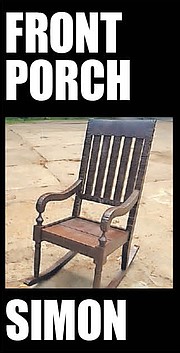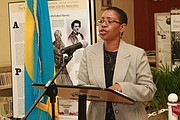KIM Outten Stubbs is a master teacher, an educator by vocation. Earlier in her career she taught at CC Sweeting, RM Bailey and St Augustine’s College. Her devotion to the subjects she taught, including Bahamian history and geography, was infectious. She was a no-nonsense teacher, but not without fun.
After making a point in the classroom or after a student grasped a fact or insight, she would offer her signature, “right?!” The “right” would be said in both a questioning and declaratory manner, the last letters extended for emphasis.
She developed her own form of the Socratic Method, asking certain questions and waiting for a thoughtful response. It is a method she still sometimes uses when engaging in dialogue with those who seek her assistance and advice.
Eventually, the attributes she demonstrated in the classroom were brought to the national stage. As a teacher, she was enthusiastic, disciplined, well-prepared, and detail-oriented. As a researcher, curator, archivist and administrator she exhibited the same tell-tale stellar qualities.
Outten Stubbs is passionate about researching, preserving and sharing the history and heritage of The Bahamas with Bahamians and others. During our 50 years of sovereignty, individuals like Dr. Gail Saunders, Outten Stubbs, and other historians and archivists have told and exhibited our stories from a Bahamian perspective.
Because of these historians and educators, we have a greater sense of our history, our identity, our possibilities and challenges. During last year’s independence celebrations there was considerably more we should have done to educate Bahamians about our history as a nation, which is considerably longer than 50 years.
Kim Outten Stubbs is this columnist’s choice for Person of the Year because she personifies a genuine patriotism and careful scholarship demonstrated during her many decades of service. She typifies some of the best of the Bahamian spirit.
She has helped to preserve and to present Bahamian history and heritage to successive generations, as well as to a wider international and Caribbean audience. Individuals like her have chronicled our many centuries old national journey.
During her years at the Archives, and later at the National Museum of The Bahamas, Antiquities, Monuments and Museum Corporation (AMMC), the Bahamas archipelago has been her classroom.
She eventually rose to become acting director of the latter in 2018 and was appointed director in 2019. She currently serves as technical consultant at the agency.
Her teaching tools and spaces include: museums, temporary and permanent exhibits, writings, school presentations and other platforms. She has also been exceedingly generous in helping numerous individuals and students with research projects.
Outten Stubbs received a Master of Arts in museum studies in 1991 from University College London, University of London. Her internships were at the Hackney Museum and the Museum of London.
One of the Hackney’s specialties is the history of immigration. The Museum of London covers “the history of the city from prehistoric to modern times, with a particular focus on social history”.
In 1980, she was awarded a Master of Arts in African and Afro-American Studies from the State University of New York at Albany. She was the recipient of the Award for Excellence in Scholarship in the Department of African and Afro-American Studies.
Her Bachelor of Arts in History and Black Studies was attainted at Luther College in Iowa in 1978. She graduated Cum Laude and was a Member of the Honorary History Society.
How did Outten Stubbs come to invest a lifetime in research and education in history, including the history of Africa and the African Diaspora, especially in the Caribbean? Listen to the storyteller recall a part of her personal journey and our collective stories.
“I have always loved history and in particular my own family’s history and oral tradition. The elderly in my family have always gathered to talk about our heritage. My immediate ancestors come from Cat Island and Caicos Island…
“When I was a little girl about ten or so my grandfather brought me from New York to Florida on the way home to Nassau.
“We stopped in a town in Florida called Carvers Ranch just outside of Hollywood, Florida, where most of the settlers were Bahamian. We arrived at night, and he took me to the home of every relative and woke them up and introduced us.
“My uncle did the same thing for me as a young woman on a visit to Cat Island, meeting relative from one end of the island to the other. These experiences helped to shape my perception of who l am, and why I do what I do, my identity.”
“This is the reason that I study history, identity, knowing who we are, where we come from so that we can better determine where we need to go.”
Outten Stubbs is passionate about understanding and preserving history: “Preserving that history whether it be in the built environment, or as intangible culture and written records is vital to nation building.”
She has played her part in nation building at the Museum/Corporation. As assistant archivist beginning in 1990, she conducted research on aspects of Bahamian History; prepared articles for newspaper publications; and participated in the formative organisation of the museums and historic preservation section of the Department of Archives.
She also participated in archaeological excavation throughout The Bahamas. In 1992, she co-curated and set up the first exhibition for the Pompey Museum. In 1993 she served as the Bahamian co-curator for Craft of The Bahamas at the Smithsonian Folklife Festival on the Mall in Washington DC.
Outten Stubbs was transferred from the Department of Education to the Department of Archives, from which the National Museum of The Bahamas, Antiquities, Monuments and Museum Corporation was eventually formed. In 1994, she became assistant curator at the Museum/Corporation.
She assisted in the drafting of the Antiquities, Monuments and Museum Act, 1998; served as the first recording secretary of the Board of the AMMC; developed training programmes for museum attendants and tour guides at the forts; assisted in the development of the Historic Preservation programme; and identified sites for the initial Historic Sites Register.
Outten Stubbs created exhibits, mounted objects, conducted research, and assisted in the establishment of National Museum satellite museums in Long Island, San Salvador and traveling exhibitions to other islands including Grand Bahama. She also participated in archaeology excavations throughout the country.
Amidst her administrative and other duties, she continued scholarly work through research, writing and editing. She has contributed to Ministry of Education publications, as well as to “Aspects of Bahamian History”, a local newspaper article series.
She helped to edit Historic Fortifications of Nassau and was a co-writer of “Straw Work: A Case Study of Continuity and Change” and “Cultural Perspectives”, both of which were Smithsonian Folklife Festival publications.
Her research topics include: the Women Suffrage Movement in The Bahamas, Lodges and Friendly Societies, Straw Craft throughout The Bahamas, Slavery in The Bahamas, Fortifications of The Bahamas, and Family Island communities.
Outten Stubbs has been fortunate to realise in both senses her public vocation and role in the country’s national development and maturation as an independent nation.
“I believe that we are all given a task, a calling, sometimes we do not have the opportunity to pursue the calling, I have been very fortunate to be able to pursue what I perceive as my calling.
“I have been blessed to receive a level of education that provided the skills and knowledge to look at how we present and study history and realise that it does not have to always be in a classroom or a book.”
There is a humility and self-effacement to Outten Stubbs, who does not like publicity: “My years of work are only the very beginning of the journey and there are many others who share the vision.
“I believe that we are making a dent in the armour, and that we should make sure that our dent is so significant that the next generation of builders will not have to come behind us and do the work again. They will be able to use our dent to step up and move forward, upward and onward in building our Bahamaland.”
Through dogged work and dedication over decades, Kim Outten Stubbs has made considerably more than a dent. She has made the proverbial indelible mark and lasting impression.
This includes her extraordinary devotion she to the realisation and the restoration of the Pompey Museum and her work toward the Museum of The Bahamas, more of which, next week.






Comments
Use the comment form below to begin a discussion about this content.
Sign in to comment
Or login with:
OpenID